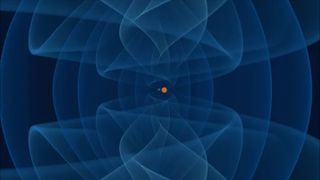Ripples in space-time point to the merger of a neutron star with another mystery object. The object, which falls right within the mass-gap range, sheds light on a long-sought, murky realm.

Astronomers announced on April 5 that they may have detected a collision between a neutron star and a lightweight mystery object — an object larger than the largest known neutron star, but smaller than the smallest known black hole. The finding sheds light on objects that exist in this murky realm, which was long thought to be empty but, in recent times, has revealed otherwise.
More specifically, a signal detected in a pocket of the universe roughly 650 million light-years from Earth indicates a rare merger between a neutron star and what astronomers suspect is a surprisingly lightweight black hole. The pair would have danced around one another and merged about 650 million years ago, generating ripples in the fabric of space and time known as gravitational waves. These waves were sensed and flagged on May 29, 2023 by a network of antennas in Japan, Italy and the U.S. associated with the LIGO-Virgo-KAGRA (LVK) collaboration.
“These are rare events,” Evan Goetz, a LIGO researcher at the University of British Columbia (UBC) in Canada, told Space.com. “It’s very exciting for the community to study as the first one of its type.”
The black hole candidate, which is about 2.5 to 4.5 times heavier than our sun, is heavier than the established limit of 2.5 suns for a neutron star — but lighter than the lightest known black hole, which weighs about five solar masses. This places the newfound object within the “mass gap,” a mysterious region that separates the heaviest neutron stars from the lightest black holes.
This discovery “hints at this ‘mass gap’ being less empty than astronomers previously thought,” Michael Zevin, an astrophysicist at the Adler Planetarium, said in a statement.
Related: Uranus and Neptune aren’t made of what we thought, new study hints
Black holes, small and big, are born from the violent deaths of immensely massive stars. A few models of how stars evolve, however, predict black holes with masses within the “mass gap” range cannot directly form from such stellar deaths.
window.sliceComponents = window.sliceComponents || {};
externalsScriptLoaded.then(() => {
window.reliablePageLoad.then(() => {
var componentContainer = document.querySelector(“#slice-container-newsletterForm-articleInbodyContent-5d2kcjJsy657xXWR3LjxFV”);
if (componentContainer) {
var data = {“layout”:”inbodyContent”,”header”:”Sign up for the Live Science daily newsletter now”,”tagline”:”Get the worldu2019s most fascinating discoveries delivered straight to your inbox.”,”formFooterText”:”By submitting your information you agree to the Terms & Conditions and Privacy Policy and are aged 16 or over.”,”successMessage”:{“body”:”Thank you for signing up. You will receive a confirmation email shortly.”},”failureMessage”:”There was a problem. Please refresh the page and try again.”,”method”:”POST”,”inputs”:[{“type”:”hidden”,”name”:”NAME”},{“type”:”email”,”name”:”MAIL”,”placeholder”:”Your Email Address”,”required”:true},{“type”:”hidden”,”name”:”NEWSLETTER_CODE”,”value”:”XLS-D”},{“type”:”hidden”,”name”:”LANG”,”value”:”EN”},{“type”:”hidden”,”name”:”SOURCE”,”value”:”60″},{“type”:”hidden”,”name”:”COUNTRY”},{“type”:”checkbox”,”name”:”CONTACT_OTHER_BRANDS”,”label”:{“text”:”Contact me with news and offers from other Future brands”}},{“type”:”checkbox”,”name”:”CONTACT_PARTNERS”,”label”:{“text”:”Receive email from us on behalf of our trusted partners or sponsors”}},{“type”:”submit”,”value”:”Sign me up”,”required”:true}],”endpoint”:”https://newsletter-subscribe.futureplc.com/v2/submission/submit”,”analytics”:[{“analyticsType”:”widgetViewed”}],”ariaLabels”:{}};
var triggerHydrate = function() {
window.sliceComponents.newsletterForm.hydrate(data, componentContainer);
}
if (window.lazyObserveElement) {
window.lazyObserveElement(componentContainer, triggerHydrate);
} else {
triggerHydrate();
}
}
}).catch(err => console.log(‘Hydration Script has failed for newsletterForm-articleInbodyContent-5d2kcjJsy657xXWR3LjxFV Slice’, err));
}).catch(err => console.log(‘Externals script failed to load’, err));
“It does appear that it could be possible now with these observations,” Goetz said. Perhaps, he says, astronomers need to tweak the models — or maybe “we really do have a more complicated evolution of a heavy neutron star that evolved into a black hole.”
“It’s hard to know just from this one example,” he said.
In early 2020, astronomers announced the first conclusive detection of gravitational waves created by a collision which involved a stellar remnant right in the mass gap range. However, the discovery team couldn’t classify the object with conviction at the time, concluding it could be either the biggest known neutron star or the smallest known black hole.
As for the latest finding, astronomers say they cannot pinpoint just where in the sky the mammoth objects merged because only one LVK detector was recording data when the signal was detected. Nevertheless, the finding has raised hopes that there may be many more such mass-gap objects out there waiting to be discovered.
“There is a lot more potentially we could find and a lot more to look forward to,” Heather Fong, a LIGO researcher at UBC, told Space.com.
After a short maintenance break, LVK detectors resumed measuring ripples in space-time on April 10. The LIGO team anticipates observing over 200 gravitational wave signals by February 2025, including hints of a few objects within the elusive mass-gap range.
The discovery was presented at the American Physical Society meeting on Friday (April 5) and is awaiting peer review.
Editor’s update 4/11: This is the first merger confirmed between a mass-gap object and a neutron star; mergers between black holes and neutron stars have been detected in the past. This article has been updated to reflect that.
Originally posted on Space.com.

READ MORE
How to Decorate a Dorm Room on a Budget
Congratulations, you made it into college. But that dorm room isn’t going to decorate itself. [...]
New breakthrough shows how short pulses of light destroy particles
An international research team is exploring how polaritons, light-matter mixed objects, respond to short pulses [...]
How Seed Banks Work
Why does poop smell bad?
And for medical purposes, how stinky is too stinky? Poop, feces, stool — whatever you [...]
These Spacey Treats Include a Galactic Smiley Face and an Interstellar Rose
A stuffed Dragon returns to Earth, Hubble spots a smiley face in the sky, a [...]
10 Bad Alternator Symptoms to Watch, Listen and Smell For
The alternator is a relatively simple component containing only a few parts, but it plays [...]
How Mosquitoes Helped Shape the Course of Human History
Mosquitos and their related diseases played a role in many historical events. James Gathany / [...]
Scientists discover new features of molecular elevator
Molecular elevator. Credit: Daria Sokol/MIPT Biophysicists from the Moscow Institute of Physics and Technology and [...]